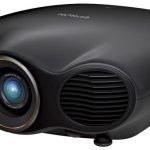 Updated May 18, 2017. This tweak does not require any physical modifications to the Epson LS10000 projector. It is derived based solely on observation of how current 2016/2017 projectors are delivering UHD HDR enabled images.
Updated May 18, 2017. This tweak does not require any physical modifications to the Epson LS10000 projector. It is derived based solely on observation of how current 2016/2017 projectors are delivering UHD HDR enabled images.
The Epson LS10000 laser based projector uses LCOS like technology similar to the JVC DILA and Sony’s SXRD versions of the same. The projector is not officially HDR capable since its HDMI inputs are “only” 2.0 rather than 2.0a. HDR … aka High Dynamic Range encompasses two main components, the Dynamic range part and the wide color part henceforth referred to as wide color gamut or WCG for short.
Like the “real” HDR projectors that are out there right now such as the Epson 6040/5040 and the many JVC units and Sony units, the projectors achieve their HDR capability with two main adjustments to the projector.
- Projector kicks into High Lamp mode
- WCG color filter slips into place in the projected light path.
The high lamp mode allows for the brighter whites on the bright end of things, amongst other things. The stars or street lights are brighter … while the good native black levels of the LCOS technology are still essentially retained even with the boost to light output. The high lamp mode on many projectors typically boosts light output by 20% to 25% over econo/eco modes in those same units. There is a second reason why the projector also kicks into high lamp mode and that is to compensate for the effects of adding the WCG filter.
The addition of the WCG color filter to the light path to get those 1 billion colors of the 10 bit color signal has a negative effect of decreasing the overall light output of the projector. This is what happens when you put more things in front of a light path, you can’t help but decrease the overall levels. So the WCG filter drops the light output of a projector in the order of 30% to 40%. It’s enough that you can normally see it happening when you switch over from regular 709 HDTV to the UHD modes.
Mathematically, this is what is more or less happening:
- 1000 lumens to start (Let’s say) in the Medium lamp mode.
- 650 lumens with WCG filter in place. (35% drop)
- 815 lumens with lamp in High mode. (650 *1.25= approx. 815)
So instead of dropping the full 35% light output, the drop is reduced to 18.5% that turns out to be harder to notice. (In subjective viewing, I’m actually finding my UHD mode to be equally as bright as the normal HD viewing which is odd indeed. I’ll put a meter up to it when I have time. )
Here is what it is for my Epson LS10000 based on the calibrated modes so understand that your mileage will vary. (High mode without the WCG filter is 114 cd (33 ft-L).
- 86 candelas (25 ft-L) in Medium Lamp mode.
- 78 candelas (23 ft-L) with WCG filter in place. (10% drop)
- 102 candelas (30 ft-L) with Lamp in High mode. (18% brighter than Medium Rec 709 HD mode)
Well what do you know, the High Lamp mode with the WCG filter on is still brighter than Medium Lamp mode. On my projector Medium is about 25% lower than High. Eco is 45% lower than High.
(Definitely not the case with the Epson 5040/6040 projectors.)
As the Epson LS10000 is not supposed to be HDR capable, we can still get to something that closely approximates the HDR performance of the “real” HDR projectors.
- High Power mode – It takes no effort to bump the projector to high lamp mode. Fan noise increase … but it increases on the other projectors as well.
- WCG color filter – Choose the Digital Cinema mode on the projector and watch it slide the color filter into place.
If you are able, you can calibrate a special color mode for UHD P3 and save it.
The proof is in the viewing. I use a Samsung UHD BD player that has a USB port that handles both MP4 and TS UHD HDR video files. I have collected a number of the Manufacturer HDR demos from LG/Sony/Samsung and these will play through the Samsung UHD player to the Epson LS10000. As an important part of this process, I would highly recommend that you get your hands on some UHD HDR patterns like the R. Masciola HDR pattern suite that is available online. Support his efforts as the price is cheap enough. With these patterns, you can set up brightness and contrast far better. On contrast, aim for the 1000 nit box which puts it around the 70-75% levels. This sets your contrast at around “0” or just less. Do not pump the contrast to 24 (max) … that adds tons of clipping and kills details … this is akin to watching in vivid mode on most sets.
Of course once you have these patterns, it will come down to how you can get them fed into the projector. You cannot plug the USB stick in directly. As noted previously, I use the Samsung UBD-K8500. The important thing here is that the media player section on the UHD BD player has to recognize the MP4 or TS files. Samsung does … the Oppo does … Panasonic doesn’t … Sony? … LG? Philips? Xbox One – No.
So how do I know that these tweaks will give the projector HDR like performance? It’s because I also have an LG UHD HDR flat panel in the same HT room on my back wall. I can send these HDR clips simultaneously to both displays and compare the results. And after accounting for the fact that flat panels are much brighter than projected images, the two presentations of the same material look essentially identical. (Below are some sample images from the room. Of course they are rough as I am taking images with a phone in a dark room.)
If you are an Epson LS10000 owner, give this a try. I’ve played with the Epson 6040 in my own home with the same set up … the LS10000 can look very similar indeed.
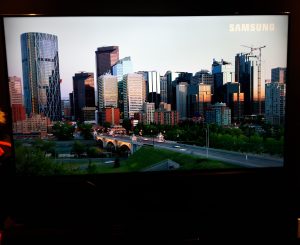
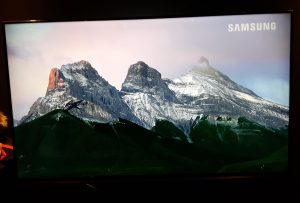
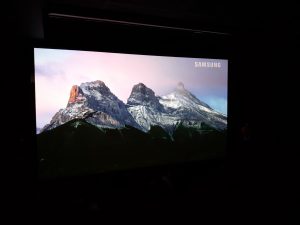
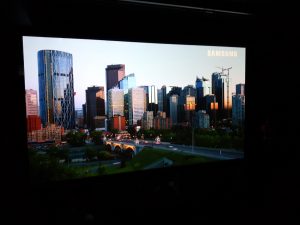
Next up … I’m going to try to build the EOTF gamma curve that they use for HDR within the custom Gamma section of the projector. (Electro Optical Transfer Function) Will report back when that is done.
To no one’s surprise, the projector cannot do the EOTF gamma curve. But!!!! You can still try to approximate it. Go to custom Gamma and take color tone 4/5/6/7/8/9 … to the end. Max all these out. Then take color tone 1 … take that to the bottom. -32 … then take 2 and 3 and build a diagonal line that connects with color tone 4 that is maxed at 32. You can eye ball this.
Try it out. Just another piece of the HDR tweaking adventure. I’m just trying to apply pseudo calibration science to the situation. Enjoy.


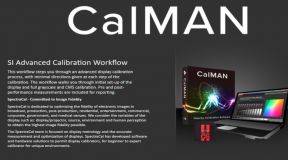

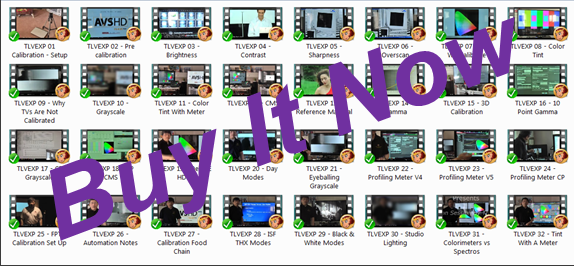
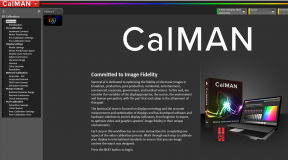
2 Comments
Nima
(April 7, 2017 - 6:55 am)Dear Michael,
I have read your article about the Epson LS10K and the (pseudo) HDR tweak. Could you please elaborate how this is done? I thought HDR would not be possible with the LS10K and was looking for a UHD player with a Strip Metadata feature like the Oppo to get SDR / BT2020. I also already own a HDfury Linker. I live in Germany and would love to tell my local calibrator to do this tweak for me but would need some guidance. Thanks a lot in advance
Best regards,
Nima
Michael Chen
(April 7, 2017 - 6:56 am)Greetings
The new HDR capable projectors do at least two main things when it comes to UHD-HDR material.
1. Wide Color Gamut – The projector slides an additional color filter into place to add the extra color palette. The Down side is that more things in front of the light path decreases the overall light output.
2. High Dynamic Range – This is more of a way to compensate for #1. Bump the projector to high lamp mode to recover some of the light loss.
3. HDR brightness and contrast patterns can also be fed into the projector. (I do this via the USB port on the Samsung 8500 UHD player)
Unlike flat panels. projectors can’t make some pixels way brighter than others since the light bulb is either on or off. High lamp mode would increase light output, but the good black levels help to retain the black floor … if you take my meaning.
The projector can then be calibrated with a 444 10 bit color signal. This can calibrate it to the P3 color gamut inside the 2020 container. You can choose the DCI gamut within the Calman software or the p3 inside 2020 option. They give different end results. P3 inside the 2020 container may end up looking funny especially on human flesh tones. Manual adjustments may be needed. (Red tint … ) This is a consideration even on “real” HDR projectors too like the JVC ones and the Epson 5040/6040. Pretty graphs do not guarantee pretty pictures if the controls don’t work right.
regards